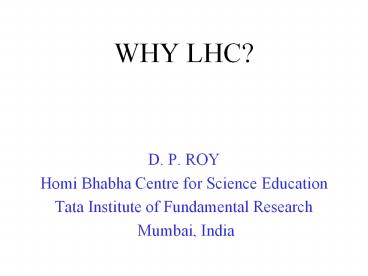WHY LHC? - PowerPoint PPT Presentation
1 / 20
Title:
WHY LHC?
Description:
Title: BASIC CONSTITUENTS OF MATTER - VISIBLE & INVISIBLE Author: MR.D.P. ROY Last modified by: dproy Created Date: 7/19/2006 5:27:46 AM Document presentation format – PowerPoint PPT presentation
Number of Views:91
Avg rating:3.0/5.0
Title: WHY LHC?
1
WHY LHC?
- D. P. ROY
- Homi Bhabha Centre for Science Education
- Tata Institute of Fundamental Research
- Mumbai, India
2
Contents
- Basic Constituents of Matter and their
Interactions Matter Fermions and Gauge Bosons
(Std Model) - High Energy Colliders
- Discovery of Std Model Particles at Colliders
- Higgs Mechanism Higgs Search at LHC
- Supersymmetry SUSY Search at LHC
- (Natural units h c 1 gt m mc2 , mp ? 1
GeV)
3
Basic Constituents of MatterMass (GeV)
- Fermions (Spin 1/2 h)
e - Leptons ?e ?µ ?t 0
- e .0005 µ 0.1 t 1.8 -1
- Quarks u 0.3 c 1.5 t 175 2/3
d 0.3 s 0.5 b 5 -1/3 - For each Pair ?e 1 gt Weak Int
- Quarks also carry Colour Charge (C)gtStrong Int
4
Basic Ints (Gauge Bosons Groups)
5
SU(2)xU(1) EW Th (GSW) gtaWa/sin2?W?4agt DAµ
?4a/MW2 gt MW80 GeV, MZ91GeV
- p (uud), n (udd), e gt All the Visible
Matter - Heavier Leptons Quarks Decay by Weak Int
- They can be Observed in Accelerator or Cosmic ray
- Cosmic ray Observation of µ and k (su) in 1947
- ?s are stable but very hard to Observe lt Weak
Int - ?e Observed in Atomic Reactor Expt in 1956
- ?µ in BNL PS in 1962 ( KGF Cosmic ray in 1965)
- ee- Collider c (1974), t (1975), b (1977), g
(1979) - p-p Collider W Z (1983), t (1995), ?t
(2000) FT
6
eBv mv2/R eB mv/R
7
ee - ( p - p) Collider
Accleration Mode
Collision Mode
Advantage of Collider over Fixed Target
Accelerator
Tevatron p-p Collider
8
PrecissionTune e-e Energy MZ gt Higher Rate
Better Mass Res Z events/yr LEP-I 10 6,
CERN p-p Coll. 10 1-2 Signal
Clean , Dirty (Debris from Spectator q g)
9
Past, Present Proposed Colliders
Period Machine Location Beam Energy(GeV) Radius Highlight
70s SPEAR DORIS CESR PEP PETRA Stanford Hamburg Cornell Stanford Hamburg ee- 3 3 5 5 8 8 1818 2222 125 m 300 m charm , t bottom bottom gluon
80s TRISTAN SPPS Japan CERN ee- p p 3030 300300 1 km W,Z boson
90s Tevatron SLC LEP-I (LEP-II) HERA Fermilab Stanford CERN Hamburg p p ee- e p 10001000 5050 5050 100100 30800 5 km Top Z Z W
2009 LHC CERN p p 70007000 5 km Higgs,SUSY
2??? ILC ??? ee- 500500
10
3-jets
91 GeV
80 GeV
11
Godbole, Pakvasa Roy, Phys. Rev. Lett. 50, 1539
(1983) Gupta Roy, Z. Phys. C39, 417 (1988)
12
lt
13
g2
Wµ
Wµ
Higgs couplings to Particles is Proportional to
their Mass gtMost Important Channels for Higgs
Search are the Heavy Pairs h ( WW, ZZ, tt, bb,
tt ) H ( tb, t? ) t Polarization Effect lt
Roy, Phys.Lett.B459, 607 (1999)
14
Ferromagnetism(Spontaneous Symmetry Breaking)
- T lt TC
- T gt TC
Rotational Symmetry Broken
Rotational Symmetry
15
(No Transcript)
16
Hierarchy Problem Supersymmetry (SUSY)
Solution
k
Without a protecting symmetry scalar mass gets
quad. div. quantum corr.
GeV
17
LSP
Weakly Int Massive Particle (WIMP)
gt LSP escapes detection like ? gt Apparent
imbalance of PT (Missing-PT Signature)
Pair production of Gluinos and Squarks at
LHC gt Multi-jet plus Missing-PT Signature for
SUSY
Reya Roy, Phys. Lett. 141B, 442 (1984) Phys.
Rev. Lett. 53, 881 (1984)
18
Conclusion
- Higgs Superparticles are the minimal set of
missing pieces reqd. complete the picture of
particle physics (MSSM). - LHC offers comprehensive Higgs and Superparticle
search up to MH,SUSY 1000GeV. - It will either complete the picture a la MSSM or
provide valuable clue for an alternative picture
Little Higgs, Extra Dim, ETC...? - LSP is leading candidate for the cosmic dark
matter 10 times the baryonic matter of the
Universe.
19
Rotation curve of nearby dwarf spiral galaxy
M33, superimposed on its optical image
20
(No Transcript)































